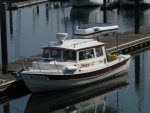starcrafttom
Active member
- Joined
- Nov 7, 2003
- Messages
- 7,972
- Reaction score
- 6
- C Dory Year
- 1984
- C Dory Model
- 27 Cruiser
- Hull Identification Number
- wn something
- Vessel Name
- to be decided later
My dad said it more succinctly: LIFE'S NOT FAIR. GET USED TO IT. He was a WWII vet and taught us this at a young age.Foggy":3nvfajx4 said:Why don't we all come to face the facts. When we're 'out there', it's a calculated
risk. No guarantees. We want to wish for the best and can the negatives. Enjoy
the day, adventure, company and scenery.
What most don't realize is we are out of our element. Hence, without extensive
training or experience, things can and do go wrong and all the pre-planning
and arm chair thought can go out the window in a moment. Face it. Even experts
fail in Mother Nature.
So, what do you do? Not dare to go? That's an option. For those who feel well
prepared and in the know, go knowing we may not return.
Some don't return. That's life. Something will end it sooner or later.
I prefer not to stay frozen on shore rather follow my passions and take it as it
comes.
Aye.
Grandpa used to say, "It's not over until it's over."
Bob, if My cruising in SE Alaska had been in a boat like your Cal 46 it would have been done with methods like you & Marie used. We of course have much more leeway maneuvering in the smaller shallower water areas in the CD 22. Where we have always had to be more cautious has been avoiding the dangerous wave conditions brought on by weather & tides & also breaking seas caused by bigger swells breaking in shallow water areas that are no problem with small swells. Even with the maneuverability & shallow draft of the CD 22, we still like you used a inflatable dingy or Mokai to first check out some of the more intricate places or following anchoring used the dingy to see if a more favorable route, then we made to the anchorage was possible. As I posted, exploring the unknown is to me challenging & enjoyable, but I also agree fully with you that preparation is the key to improve the odds against bad luck. Risk assessment needs to be made & in extremely hazardous conditions like our exiting of Dry Pass on the outside waters of Chichagof Island this year, I prepared by not only doing much previous reconnaissance of the area in the C-Dory & inflatable boat, but had also climbed the bluffs above for a visual & downloaded satellite photos of the Pass on my IPad, so I would know exactly where the blocking kelp was located & just where the boat needed to be placed. Even that preparation would not have been worth much if the boat was not properly driven through the rocky maze, kelp & narrow exit into the 6 foot swells at the entrance. In 2007, we exited this Pass the 1st time at 4 AM in light fog & worse sea conditions with only the incorrect information in the Hemmingway-Douglas guide book & a quick visual the previous day at low tide for preparation, which goes to show luck can be useful just not dependable.thataway":2r9qodd8 said:One technique we used when we had the Cal 46 (6' draft), was I would go with the RIB first thru an area. Some difficult ones, we both rode thru in the RIB (which had a good depth finder), and then Marie would run the big boat only a few feet behind me, and I would go first in the RIB. Communication by VHF radio.
Yes voyaging can be "dangerous"--but the goal is to minimize any danger by preparing. I also like to have as much information as possible. I thought that the Hemmingway-Douglas books were a good resource. The first one appeared when we were circumnavigation Vancouver Island and was on the inland passage in 1995. We only used it to review parts of the inland passage, on the West side of Vancouver Island. There were a few errors from what we observed.
On both our lap top (open cpn running NOAA charts) and our chart plotter (Garmin 2010C) our route was on land for most of our trip on the St John River in Florida (it was at at least near the river)

